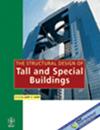大跨度三中心圆柱屋顶结构非高斯风压的峰值因子估计方法
IF 1.3
3区 工程技术
Q3 CONSTRUCTION & BUILDING TECHNOLOGY
引用次数: 1
摘要
由于低估了极端风引起的表面压力,覆层容易受到损坏。常用的峰值系数估算方法(用于确定包层设计荷载的输入)涉及复杂的计算密集型程序。本研究开发了一个四参数统一的风压自谱模型,通过分析三中心圆柱屋顶上的风洞风荷载数据,简化了风致表面压力的峰值因子估计。通过对两个具有不同曲率的大跨度三中心圆柱屋顶结构的风洞风压测量的统计分析,确定了模型参数的值。该研究通过检查标准化风致屋顶压力的概率密度函数以及风压时程的三阶和四阶统计矩,确定了具有非高斯特征的屋顶区域。本文最终提出并评估了一种估计非高斯区域峰值因子的简化方法,即三参数埃尔米特模型,该模型是通过基于矩的埃尔米特模型、修正埃尔米特模型和本研究中完成的参数简化导出的。结果表明,风致屋顶压力的自谱模型可以准确估计零阶和二阶谱矩,反映了风压波动特征和谱曲线的几何特征。与基于矩的埃尔米特模型和修正埃尔米特模型的峰值因子相比,三参数埃尔米特模型估计的峰值因子误差均小于10%。这些结果表明,三参数Hermite模型以可接受的精度简化了计算。本文章由计算机程序翻译,如有差异,请以英文原文为准。
Peak factor estimation method of non‐Gaussian wind pressures on long‐span tri‐centered cylindrical roof structures
Claddings are susceptible to damage due to underestimation of extreme wind‐induced surface pressures. Commonly accepted methods for estimating the peak factor (an input used to determine cladding design loads) involve complex calculation‐intensive procedures. This research develops a four‐parameter unified auto‐spectral model of wind pressure to simplify peak factor estimation of wind‐induced surface pressure via analysis of wind tunnel wind load data on tri‐centered cylindrical roofs. Values of the model parameters were identified via statistical analysis of wind tunnel wind pressure measurement on two long‐span tri‐centered cylindrical roof structures with different curvatures. The study identified roof regions with non‐Gaussian features by inspecting probabilistic density functions of the standardized wind‐induced roof pressures and the third‐ and fourth‐order statistical moments of wind pressure time histories. The paper ultimately proposed and evaluated a simplified method for estimating the peak factors in the non‐Gaussian regions, the Three‐parameter Hermite Model, derived through the moment‐based Hermite Model, the Revised Hermite Model, and the parameter simplification accomplished in this study. The results show that the auto‐spectral model of wind‐induced roof pressures can accurately estimate the zero‐ and second‐order spectral moments, which reflects the wind pressure fluctuating characteristics and geometric features of spectral curves. Compared with the peak factors of the moment‐based Hermite Model and the Revised Hermite Model, the peak factor errors estimated by the Three‐parameter Hermite Model are all less than 10%. These results suggest that the Three‐parameter Hermite Model simplifies the calculation with acceptable accuracy.
求助全文
通过发布文献求助,成功后即可免费获取论文全文。
去求助
来源期刊
CiteScore
5.30
自引率
4.20%
发文量
83
审稿时长
6-12 weeks
期刊介绍:
The Structural Design of Tall and Special Buildings provides structural engineers and contractors with a detailed written presentation of innovative structural engineering and construction practices for tall and special buildings. It also presents applied research on new materials or analysis methods that can directly benefit structural engineers involved in the design of tall and special buildings. The editor''s policy is to maintain a reasonable balance between papers from design engineers and from research workers so that the Journal will be useful to both groups. The problems in this field and their solutions are international in character and require a knowledge of several traditional disciplines and the Journal will reflect this.
The main subject of the Journal is the structural design and construction of tall and special buildings. The basic definition of a tall building, in the context of the Journal audience, is a structure that is equal to or greater than 50 meters (165 feet) in height, or 14 stories or greater. A special building is one with unique architectural or structural characteristics.
However, manuscripts dealing with chimneys, water towers, silos, cooling towers, and pools will generally not be considered for review. The journal will present papers on new innovative structural systems, materials and methods of analysis.

 求助内容:
求助内容: 应助结果提醒方式:
应助结果提醒方式:


